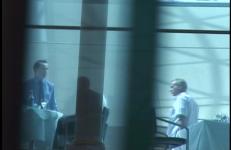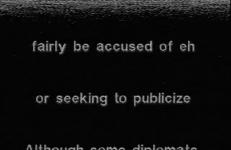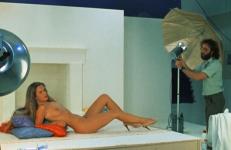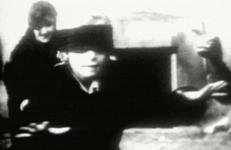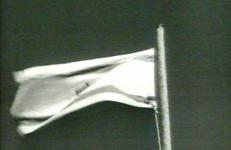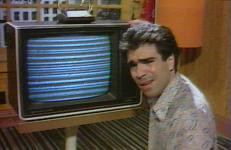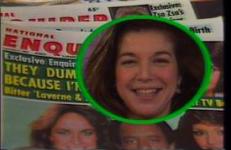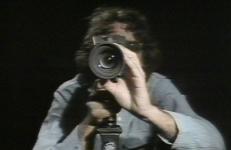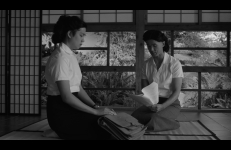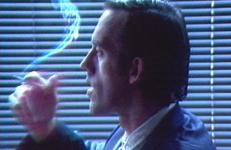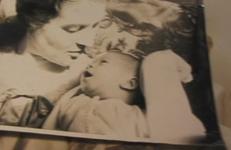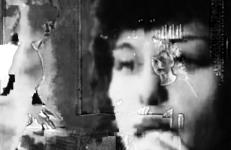How Little We Know of Our Neighbours is an experimental documentary about Britain's Mass Observation Movement and its relationship to contemporary issues regarding surveillance, public self-disclosure, and privacy. At its center is a look at the multiple roles cameras have played in public space, starting in the 1880's, when the introduction of the hand-held camera brought photography out of the studio and into the street. For the first time one could be photographed casually in public without knowledge or consent.
Media Analysis
There is a crudeness to How's Tricks, Benglis's first venture into narrative fiction. No attempt is made to hide the mechanics of making the tape. At one point, while Benglis and [Stanton] Kaye argue about the tape they are making of [Bobby] Reynolds (a real-life carny who also appears in The Amazing Bow-Wow), Kaye is seen reaching over to turn off the video recorder — and thus the scene ends...
There is a crudeness to How's Tricks, Benglis's first venture into narrative fiction. No attempt is made to hide the mechanics of making the tape. At one point, while Benglis and [Stanton] Kaye argue about the tape they are making of [Bobby] Reynolds (a real-life carny who also appears in The Amazing Bow-Wow), Kaye is seen reaching over to turn off the video recorder — and thus the scene ends...
A formidable collage of striking images, this powerful and provocative work confronts racial violence through images of ecological mayhem, machismo, pornography, and Third World poverty — images which return to the taboo body of a black man. "Directed and produced by our culture," An I for An I studies how violence is internalized and psychologized by overlapping soundtracks, printed texts, recurrent images, doctored footage and split screens. The piece attacks racist culture and pleads for an alternative recourse to violence.
Taken almost verbatim from a newspaper, The Arizona Daily Star, the video recounts the story of Ramona Barrrara, a New Mexico woman who saw the face of Jesus in a tortilla when she was rolling her husband's burrito. In an attempt to manipulate the media to her advantage in publicizing this miraculous event, the media ultimately exploited the most important event of this woman's life for its sensational value.
This video examines the iconic World Wide Web branding of the global marketplace, which creates disconnection and contrasts with the labor system in society.
In a fusion of text and image, Rosler re-presents the NBC Nightly News and other broadcast reports to analyze their deceptive syntax and capture the confusion intentionally inserted into the news script. The artist addresses the fallibility of electronic transmission by emphasizing the distortion and absurdities that occur as a result of technical interference. Stressing the fact that there's never a straight story, Rosler asserts her presence in a character-generated text that rolls over the randomly erased images, isolating excerpts from the broadcast sources.
"Four days spent in a studio working on a centerfold photo for Playboy magazine provided the subject matter for my film. The magazine itself deals with culture, cars, a certain lifestyle. Maybe all those trappings are only there to cover up the naked woman. Maybe it's like with a paper-doll. The naked woman in the middle is a sun around which a system revolves: of culture, of business, of living!
In The Blood is an experimental documentary about American-Jewish attitudes towards Germans, and the role the Holocaust plays in shaping Jewish identity. This layered collage combines appropriated images, original footage, sampled sounds, and fragments of audio conversations, to examine perceptions and representations of Germany, cultural identity, collective memory, and history.
With a combination of Hollywood, European, and Israeli film; documentary; news coverage; and excerpts of 'live' footage shot in the West Bank and Gaza strip, Muqaddimah Li-Nihayat Jidal (Introduction to the End of an Argument) critiques representations of the Middle East, Arab culture, and the Palestinian people produced by the West. The video mimics the dominant media's forms of representation, subverting its methodology and construction.
With a combination of Hollywood, European, and Israeli film; documentary; news coverage; and excerpts of 'live' footage shot in the West Bank and Gaza strip, Muqaddimah Li-Nihayat Jidal (Introduction to the End of an Argument) critiques representations of the Middle East, Arab culture, and the Palestinian people produced by the West. The video mimics the dominant media's forms of representation, subverting its methodology and construction.
A chilling and revealing look at bureaucratic techno-speak, Finley provides a course in “official” media rhetoric, presenting terms and decoding for the audience (i.e. "soft target = city”, “involuntary conversion = crash”) against a slow-motion collage of military imagery. This intensely visual video illustrates how the urban environment has become the site of tactical language, rendering our daily lives in a science-fiction state of constant fear. The visual elements create a rhythm of threat that is punctuated by high altitude shots of military jets.
Tapping into cable because of his lousy reception, Mike gets more than he bargained for as he unwittingly becomes trapped in the medium—the “star” of his own cable TV show. Due to an incomprehensible mishap, Mike’s rewired TV now transmits his image to the world; the observer has become the observed. Turning the tables on viewership in a way that reflects the banality of television, Smith touches on identification with television, and the manner in which television re-presents our world back to us.
Award winning documentary filmmaker and cultural critic Joan Braderman takes a look at the National Enquirer and demolishes the newspaper's ideology and content. Analyzing the fact that the Enquirer is the tabloid that everybody reads but nobody admits to. Braderman shows how it's agenda of reporting gossip and the lowest common denominator of news has influenced even the so called intellectual progressive media such as the "New Yorker" and the "New York Times". Braderman has recently finished her documentary The Heretics about a seventies feminist art group based in NYC.
In Joan Does Dynasty — a hilarious classic of feminist media deconstruction — critic Braderman literally projects herself onto the set of the favorite series of one hundred million people in 78 countries. Her do-it-yourself deconstruction of TV’s most successful night-time soap opera is at once a succinct critical analysis of the disturbing cultural assumptions inherent in the narrative, and an unabashed appreciation of the show’s seductive power.
A video in two parts (Starstruck and MGM: Movie Goddess Machine), focusing on celebrity culture, identity, and the body. “What is Liz Taylor doing in my bed, in the bed of my friend Leland, as he dies of AIDS?” These and related questions are enacted in a series of encounters between the artist/ performer/ spectator and a host of famous people from la Liz to Anita Hill. In Joan Sees Stars, Braderman addresses the subversive potential of masquerade in a parade of video-assisted star sightings.
"Noted critic Judith Williamson ventures from her English home to a shopping mall in Southern California to proffer some opinions on the working of American culture under capitalism. Using the exponential increase in the numbers and styles of socks available in the marketplace as a wry point of departure, Williamson shops for socks and questions the dubious need for a specific style of sock for just about any endeavor one could name."
—1987 AFI Video Festival Catalogue
Using selected details of TV’s Hollywood Squares, Birnbaum constructs an analysis of the coded gestures and “looks” of the actors, including Eileen Brennen and Melissa Gilbert. Birnbaum exposes television as an agent of cultural mimicry and instruction. The actors’ expressions are far from valueless; they are the ideological content of such programming.
Timely concerns about the future of video, artists’ complicity in the money making system of the ‘establishment,’ and the effect of the camera’s presence on personal encounters, is discussed and debated in this late night video produced by David Cort, Chuck Kennedy, and Skip Blumberg.
Produced in Liege for Belgium TV, this tape considers how broadcast television functions in a multi-lingual area. A televised Tower of Babble, Muntadas shows the rigid conformity of style and content enforced through the medium, drawing attention to the similiar format of the programs broadcast in different languages.
A shot-for-shot remake of the climax of Tokyo Story (Yasujiro Ozu, 1953). Screen Left uses the original Japanese text delivered orally, with subtitles literally translated into English. Stage Right repeats the scene, with the English subtitles authored by the Criterion Collection delivered orally, with subtitles literally translated back to Japanese.
Which celebrity do you most resemble? For artist Kip Fulbeck, this question starts a rollicking ride that is part autobiography, part family portrait, part pop-culture survey, and all Disney* all the time. Watch as Fulbeck documents his uncanny resemblance to Pochahontas, Mulan, Aladdin, and other "ethnically ambiguous" animated characters. Both hilarious and touching, this educating video examines the muting of race in mainstream media and its effects on multiracial Americans. *Disney is a registered trademark of Disney Enterprises, Inc.
Listen To This is a fragment of collective memory that finds critical relevance in contemporary Queer discourse. Tom Rubnitz weaves narration, image, and a form of temporality, dislocated from ‘real time’, into a video where artist and AIDS activist David Wojnarowicz’s loss and anger is palpable.
Locke’s Way is the photographic path to knowledge, full of twists and turns, treacherously steep. What has happened down here? A family’s photographs tell us everything and nothing about the subterranean past. "One of the central questions of philosophy has always been: what can be known? Locke’s Way provides a vivid illustration of this perennial philosophical dilemma. In this short video, Donigan Cumming is preoccupied with the story of his older brother, who seems to have been brain-damaged and spent much of his life in institutions.
Lossless #2 is a mesmerizing assemblage of compressed digital images of Maya Deren and Alexander Hammid’s 1943 masterpiece Meshes of the Afternoon. Baron and Goodwin play heavily with Teiji Ito’s 1959 soundtrack, making the film’s lyrical ambience feel more astonishing than ever before. --Neil Karassik




